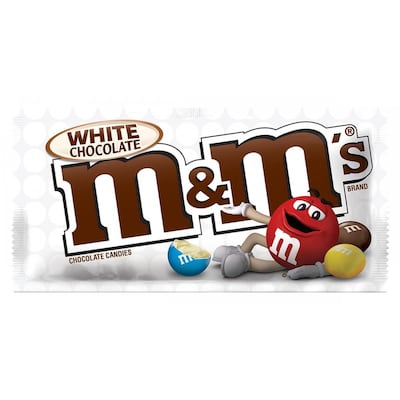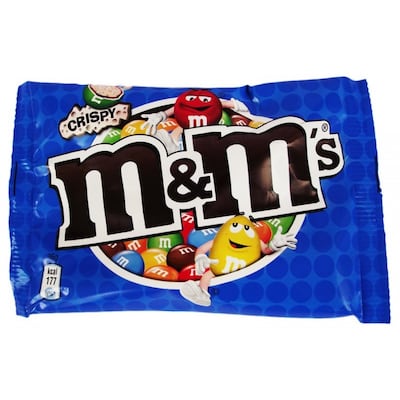To the uninitiated, M&M’s might seem like expensive Smarties with better marketing. They come in a similar range of colours and don’t seem to taste very different. Smarties, which are made by Swiss behemoth Nestle, seem to be aimed solely at children, however, and have just one product.
On the other hand, M&M’s are for anyone with a sweet tooth and come in a variety of types, from the classic chocolate, to peanut and salted caramel. Commercials, which often reference cartoon characters involved in naughty bedroom action with humans, seem to be aimed at adults.
M&M’s have been around a surprisingly long time. The first ones were created with plain chocolate in New Jersey in 1941 by Bruce Murrie and Forrest Mars – hence the M&M. They were both sons of confectionary company owners, one at Mars and one at Hershey. The Mars family still retains control of this billion-dollar private company that makes these sweets. Peanut M&M’s followed in 1954, but the kaleidoscope of colours was not introduced until the 1990s.
Until recent years, the advertising slogan associated with these was that they “melt in your mouth, not in your hand”. The barrier to that is the carnauba wax, a glazing agent made from the leaves of a palm tree mainly found in South America. It has one of the highest melting points of all the natural waxes and doesn’t dissolve in water – or sweaty palms, though the bright colours do run. A documentary aired by German public broadcaster ARD in 2017 highlighted the harsh conditions the workers gathering the wax suffered. In that instance, the spotlight was turned on Haribo, which uses the wax as a glaze. Mars is far from the only other company using carnauba wax and it turns up in a lot of places, particularly as car wax.

The plain chocolate M&M’s have a fairly standard list of ingredients incorporating a selection of milky powders, three types of sugar, oils, colours and flavourings. But the peanut and salted caramel varieties major in E numbers.
In the peanut M&M’s, these include E100, E120, E133, E160a, E160e, E171. These are all colourings. E100, which gives a yellow colour, is better known as curcumin, which is derived from the turmeric plant. E120 is natural colour that comes from “the body and eggs of an insect,” according to Safefood, the all-island food safety promotion body. (Whoever said we would be eating insects in the future was right.) It is more commonly known as cochineal. E133, or brilliant blue, is an artificial dye produced from petroleum. E160a and E160e are carotene and give an orange colour. E171 is titanium dioxide, a natural colour extracted from the mineral ilmenite. It is used to make whites brighter and appears everywhere from cheese to toothpaste.
The salted caramel M&M’s have all of those plus E150a, E162 and E172, which all are used as colourings too. E150a is an artificial caramel colour created through heat treatment of carbohydrates in the presence of acids, alkalis and salts. E162 is beetroot red, a natural colour produced from beets. E172 refers to iron oxides and hydroxides. It is naturally found in rusts, but is produced artificially from iron sulphate.
It is noticeable that American sweet manufacturers don’t shy away from printing E-numbers in the list of ingredients in the way that European companies do. Sweets that contain “beetroot red” sound a lot more appetizing than those listing E162 even though it is the same thing. Likewise, curcumin, with its association with good health, sounds more appealing than E100.

Of more concern than the E numbers is the fact that all M&M’s are made in the same facilities. This means that plain M&M’s have to display the warning that they “may contain peanut, hazelnut and almond”. A peanut allergy can lead to anaphylactic shock and can be fatal. Bizarrely, the notice is hidden on the back in writing that does not stand out against the blue background. This is surprising given that increasing numbers of children who appear to have this problem.
Check the label on Crispy M&M’s and you will also see that they have “barley malt extract” listed in the ingredients, which is a popular flavour enchancer. It is highlighted in bold because barley contains gluten. Some products that are labelled gluten free do contain barley malt extract, meaning the product contains such low levels they are believed to be safe.
That’s doesn’t seem to be the case here – even though a number of websites aimed at coeliacs have deemed them fine.
What Mars does best is marketing. Kylie Jenner keeps a bowl of pink-and-white M&M’s with her face stamped on them in her office.
How sophisticated is that?
FOOD LABELS SERIES
- Bread
- Soup
- Crisps
- Sliced ham
- Cream crackers
(search other food labels articles here)


















